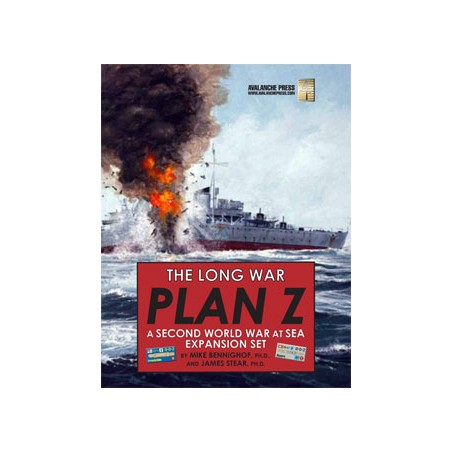- Not available




























During the late 1930’s, the German Kriegsmarine came up with a plan for a powerful new fleet, built around several aircraft carriers and a half-dozen huge battleships, with flotillas of supporting cruisers and destroyers. Admiral Erich Raeder called this ambitious program Plan Z, and looked to complete it sometime in 1948. When war actually broke out in 1939, none of these ships had been completed or even started.
Plan Z is a massive expansion set for Second World War at Sea, kicking off a new alternative history setting we’re calling The Long War. It features the ships and planes of Plan Z, pitting them against the Royal Navy and the additional ships and planes of its own building plans.
 Security guarantees
Security guarantees
100% secure payments: PayPal, Visa, MasterCard, bank cards, alternative payments.
 Delivery policy
Delivery policy
Deliveries by Mondial Relay or Colissimo (French fast postal service).
 Returns policy
Returns policy
Returns accepted up to 14 days after delivery
It’s an expansion set for an existing game, Second World War at Sea: Bismarck, and also draws on two other games, Arctic Convoy and to a lesser extent, Sea of Iron.
There are 510 brand-new die-cut (and silky-smooth) pieces. The huge H-class battleships are here, M-class cruisers, P-class battle cruisers and much more.
There are also thirty new scenarios based on the battles that might have been waged in the North Atlantic in this alternate world. This module is not playable by itself, but requires ownership of Bismarck, Arctic Convoy and Sea of Iron to enjoy all of the scenarios.
We toyed around with the idea of a stand-alone Plan Z boxed game (played out on two new Central Atlantic maps placed directly south of the maps in Bismarck, with action based around invasions and counter-invasions of the Azores, Madeira and the Canary Islands), but that didn’t seem as likely to inflame the masses with desire and it would have had a lot of overlap with Bismarck. So our Plan Z plan called for a book with a sheet of playing pieces, physically identical to many of our other products. It would have included the ships of the ambitious German Plan Z, which would have fought the British Royal Navy from Bismarck on the Bismarck maps.
That wasn’t enough. The entire Plan Z wouldn’t fit on one sheet of pieces (it came close, but not quite). But I wanted them all in there, so we added more pieces. But the scenario set didn’t really work well with only additional Germans: the Royal Navy needed more firepower to balance the scenarios, and the backstory definitely implied that the British would have had at least some opportunity (and definitely an incentive) to respond to the German building program. It’s hard to build a half-dozen battleships in complete secrecy, even in a harsh dictatorship.
Along with the new ships – everything that Plan Z included, from gunboats to battleships - the set also needed new aircraft pieces, to fill the decks of the planned aircraft carriers, and to provide reconnaissance and air cover from land bases. Plus submarine flotilla markers. All told, it came to two and a half sheets of pieces: 170 double-sized “long” ship pieces and 360 normal-sized square ones. We printed them as die-cut pieces, the silky-smooth type we’ve been using for a while now with only a minimal impression on the reverse side. They show off the new ship artwork – and there is a lot of new ship artwork – very nicely.
We use those new pieces in a set of 30 new scenarios. Most of them are set on the maps from Bismarck, but a few scenarios take place on those from Arctic Convoy (we needed an excuse to use those helicopter-equipped German convoy escorts to fight off British submarines). The scenarios are set in our new Long War alternative history, which was crafted specifically for Plan Z. In this warped reality, Poland allies with Germany in the summer of 1939, Finland holds out long enough to extend the Winter War into the spring of 1940, and Germany intervenes with maximum force as soon as the weather clears. The Soviet Union is defeated while Britain and France stand by, watching the vile dictatorships destroy one another. Finally Germany turns against the West in the summer of 1942, with France falling to the panzers during the following autumn. By early 1943 Britain stands alone, and Germany has completed most of her Plan Z fleet.
The stage is set for a climactic naval campaign.